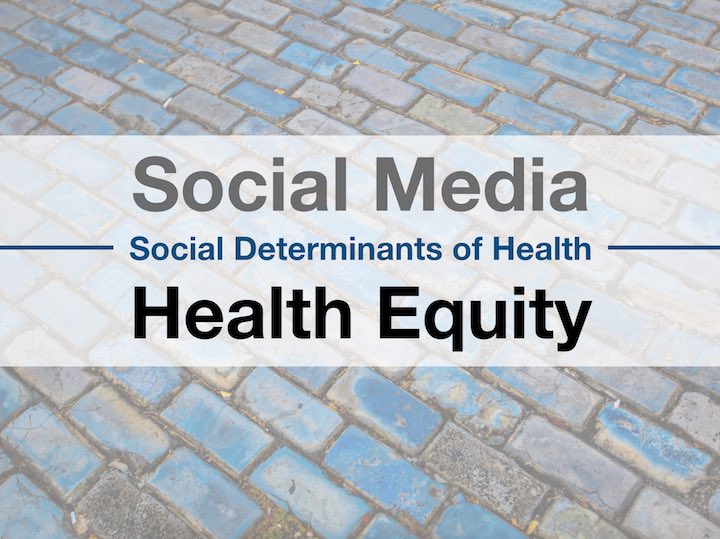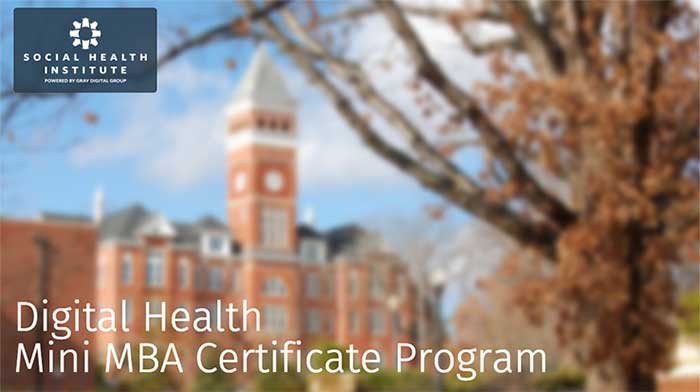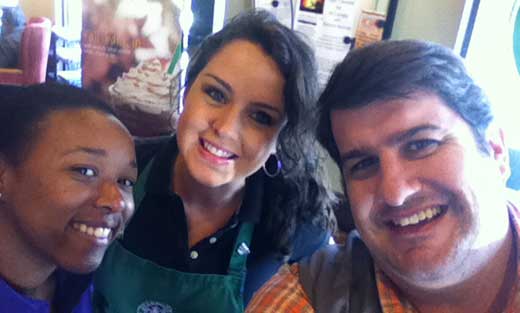Webinar hosted by Clemson Center for Corporate Learning, to learn more: ThinkClemson.com
A few years ago I began researching health equity and social determinants of health (SDoH) mainly as result of my intentionality to join the diversity and inclusion conversation inside healthcare organizations.
The more and more I have researched, the more conversations I have shared with thought leaders, the more my interest has grown. I have specifically become intrigued by the intersection between SDoH and the use of social media inside healthcare organizations.
Interesting tease article here from Ragan’s Health Care Communication News, and article begins to scratch the surface for digital rounding. Here we have an infographic from Ubicare.com showcasing the pathway from patient to the content management system and reducing the amount of time the provider has to connect with the patient for repetitive tasks. The one piece we are missing, leveraging these tools to create a connection between the patient and provider. Specifically automation leads to a quality provider/patient experience.
Yes…I said it…give them the middle finger and prove them wrong!
What is your passion?
Many times, I am asked to speak to college students and they always want to know my path. They want to know what I do and how I was able to get where I am today. I always ask them, what is their dream job? I ask them to tell me, what would they do if money did not matter!
Many students struggle with that question, having a hard time to frame the wisdom of what tomorrow might hold, given the frankness and reality of their upcoming graduation. I ask them…what is you passion?

I have spent my years serving in roles that were very tactical, executing very tactical concepts using technology where the job was dependent upon the precision of that technology. I have also learned how to shift that very tactical thinking into broader applications, preparing for long-term strategic opportunities.
During the time I was working on a large portion of my graduate research, I began to study the principles of techne and praxis.
I’m very excited to share with you something I have been working on for quite some time.
We have all been very busy at the Social Health Institute developing a Mini MBA Certificate Program with our friends at Clemson University. A year in the making, this six-course offering provides a unique approach to deliver thought leadership in the space of digital communication, social media communication and healthcare business management.
It was just the other day…I received another note in the mail from one of my students. I love it. They always let me know how they are doing, where they are going, and the dreams they are chasing.
There is this massive debate…how can we take South Carolina’s educational system and turbo charge it, innovate, and move ahead of the pack.
I think it is pretty simple…quit teaching and start inspiring. Move away from the regurgitative learning process and aim towards engaging conversation. If we want to create change, build a brighter South Carolina…why not inspire students to do more than just be students.
Institutional learning has it’s place…but there is a new student emerging in South Carolina. More and more students I work with in higher education…the more I realize there is an underlying need to take part in social justice. These students want to be a part of the solution…they want to create not only “their” tomorrow but also solve age old problems.
It seems so simple…but this is so hard to execute. Why, we have to change the way we think, we teach, create curriculums, the way we grade, the way we prepare these students for industry, and on and on. But what do we have to lose…nothing!
We have so much to learn from this new class of students…we should take off our teacher hat and put on our student hat. We should start learning from those who are inspired to learn. That is why I am sharing the video above…I learned so much from Riley Csernica.
Riley had a few dreams:
1) 3 degrees by the age of 23
2) Start a business in South Carolina
We educators, business people, legislators have a lot to learn from the Riley’s of the world. We better get out our note pads, take some notes, because her class of innovators will be leading us into the next century.
Here is a story from the GSA Business concerning the first MBAe Class at Clemson. Riley was one of those students and I had the tremendous pleasure working with…each of them were extremely special!
——-
From GSA Business
Clemson students recently finished competing for $40,000 in seed funding to launch their businesses.
First place: Brenda Morris-Wilson’s received $20,000 for her company to continue developing a clothing line for baby boomers residing in assisted living and nursing home facilities.
Second place: Riley Csernica of Tarian Orthotics received $6,000 to further commercialization of a more mobile and functional brace for those with shoulder dislocations.
Third place: Team Dabble, comprised of Carlisle Kennedy, Brendan Lopes and Josh Lopes, earned $4,000 to help expand the team’s mobile application from Clemson to other universities across the Southeast. The app aims to connect college students through events.
The students had to apply to the MBA program with a business concept in mind. The yearlong program aims to equip them with the resources needed to launch their concept. The students will graduate in August.
“The goal is to help these young people launch a successful business,” said Gregory Pickett, the director of Clemson’s new MBA program. “Each student comes into the program with an idea that gets them started. Throughout the year, they evaluate that idea and refine it, or pivot from it.”
Students learn from business people, both in and out of the classroom, about software and app development, intellectual property laws and financing, for example.
Students also work to secure capital and build on their business plans. They put the MBA concepts into practice, getting a head start on their startups while earning their degree.
http://gsabusiness.mappsite.com/news.php?link=http://www.gsabusiness.com/news/47872-clemson-students-compete-for-40-000
There is no better affirmation of success than seeing your “Students” succeeding and excited about life. Teaching at Clemson is the one thing that has changed my business approach and has helped me grow professionally everyday. As I sit here in Starbucks in downtown Clemson, I have already seen two students who have gone through my Business Writing and Entrepreneurship classes…each of them excited to say hi!
Their vibrant smiles remind me everyday why we as professionals should try to teach, give something of ourselves to those who will change the face of tomorrow. On this Clemson Homecoming weekend, it is so much fun to come home to Clemson weekly and see those students who have taught me something special about life.
When I walked into class today…I could not have been so excited! SO PUMPED!
I sat and watched five different groups give five different presentations about the business models behind their Hybrid Entrepreneur project. But, this is not just a project…these were five legitimate business ideas. Each one, tremendous…innovative…socially driven…potential to generate a profit…created to make change.
But…here is the BUT. Are these students looking at these business ideas as a project for a grade or will they turn them into a viable business idea? What is the barrier that keeps students in the academy from taking a business idea generated in a class, translate into a passion, and produce a viable business?
This takes me back to my fundamental question: can you teach entrepreneurship in a traditional education model. What do I mean? Well, we teach students that we measure success in terms of A’s, B’s, C’s, D’s, and F’s within a timeframe of the semester. It is my humble opinion that entrepreneurs build businesses beyond the timeframe of a semester and do not measure success within a frame work of grades.
Think for a second, if a student generates a great idea inside a class…how can we change the culture so that they see the value of generating this big idea into a concrete business beyond the end of the semester. Each of these five groups have tremendous business ideas, but the common resistance to capitalize on this idea is the grade they are working to achieve. Also, when the semester ends…out of sight, out of mind.
I was riding around on Saturday with one of my mentors. We were chatting up ideas, business ideas….ideas that can scale into profitable businesses. As we were chatting, we were not focusing on just the future revenue streams but the creative outlet to translate a great business idea into a scalable success. If we had a white board in the SUV, we would have been writing all over the place, connecting the dots. There is a passion behind entrepreneurship that is not measured inside the constraints of semesters and grades.
Now, back to the classroom.
At the end of the class…I challenged each student. I asked them, what would it take to take their business idea and bring it to fruition. They sat perplexed, thinking about all the other classwork they had to complete. They murmured about time and the lack of resources. So, how do we teach passion and how do we provide the access to resources to convert ideas into reality?
I say we have to take the education of entrepreneurship outside the walls of semesters and grades. We have to provide a shift in culture. Academic institutions have to invest not only in the instruction of entrepreneurship, but also the financial resources that takes good ideas and brings them to life. We see this in the business world. Look at SCLaunch investing dollars in high impact start-ups with the hope they will create jobs in South Carolina. We see new groups like the Upstate Carolina Angel Network connecting good ideas with capital to bring these ideas to life.
So here is my question, how about bring capital into the walls of the academy, investing dollars in students’ ideas for a stake in the business. Many times, I think the barrier here is the ownership of the idea. What do I mean, well institutions are interested in revenue and intellectual property. They might argue these ideas were created inside the walls of the classroom, giving them an immediate ownership of the intellectual property.
So here is my thought, my question: how can we create a culture of entrepreneurship inside the walls of academic institution to truly generate great ideas and bring them to life. We must change the culture of the academy and create a culture of real entrepreneurship…bringing good ideas to life.
I will leave you with this story. A few months ago, I had the privilege of meeting Doris Buffett. She told her story about her eagerness to give away all her money. She created the Sunshine Lady Foundation to do just that…give it all away. But, she does not invest in SOB’s (as she so eloquently stated). SOB stands for Symphonies, Orchestras, and Ballets. She invests in human capital. One of her initiatives is the Learning By Giving initiative.
“The goal of the Learning by Giving program is to support and promote the study of philanthropy at the undergraduate level nationwide in order to prepare, empower and inspire young adults to become effective, knowledgeable and skilled philanthropists and leaders in their communities. The Learning by Giving Program achieves this goal by supporting undergraduate courses in philanthropy with grants of $10,000 for students to distribute in local nonprofits as an investment in solutions to community problems. The Learning by Giving grants enable undergraduates to experience firsthand the art and science of philanthropy through courses offered in a variety of academic disciplines; and encourage the growth of undergraduates’ philanthropic values and leadership activities over their lifetime.”
WOW! Here is a lady teaching the idea of philanthropy by providing grants to support students in their desire to help local nonprofits as investments in solutions for community problems. She is providing the resources, teaching philanthropy with seed money. Imagine taking this idea and supporting entrepreneurship at the undergraduate level. Seed money supporting the ideas of tomorrow.
As you know, I have been teaching the idea of Hybrid Entrepreneurship at Clemson and it is amazing how the class is evolving. What are we finding, that it is hard to define exactly what a hybrid entrepreneur and how it is applied to a business.
Here is our basic definition: A hybrid entrepreneur is an entrepreneur that has identified a social cause and using an entrepreneurial business idea to solve this social problem and will generate a profit.
The most common example is Tom’s Shoes. For each pair of shoes Tom’s Shoes sales, they donate a pair of shoes to a child in need. Solving the social problem of children in need, yet generating a profit from the enterprise.
The biggest debate in the class, does this business model have to start with the social cause as the main focus; or can the business have a great product/service and searches for a social case to solve as a way to meet the criteria. There is an in-class debate either way…but it is my opinion that it comes to the social cause as the main initiative. I think there is a hierarchy in this definition:
1) Entrepreneurial
2) Solving Social Problem
3) Generating A Profit
There are so many organizations in the latest “Green” movement to “Save The Earth.” There is a whole class of individuals that have the social desire to solve social problems, but they do not want to create non-profits…they want to generate a profit. They want their cake and eat it too! I do not blame them.
So for the rest of the semester, the students of this class have two months to identify a social problem, create and start a entrepreneurial business model, document the process, and present their business. Yes…two months. They have lots of work to do and they have some cool social business ideas. Bottom-line, they have to find something that is micro enough to get it up and running and find a way generate a profit.
We are in the process of reading a book called “Starting from Scratch” by Wes Moss. It is a book full of case studies of entrepreneurs that have found their passion, started a business, and succeeded against the odds. This book has a few that might fit the hybrid business model. So why am I telling you this…because I want this class to be able to write the book on hybrid entrepreneurship. I want this class to be the first to really talk and explain this model, research and find case studies of examples, and put the model to work.
It is my hope this class comes closer to helping us all define what hybrid entrepreneurship is all about.







